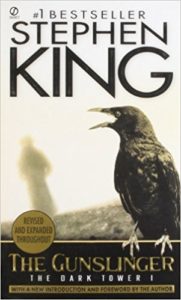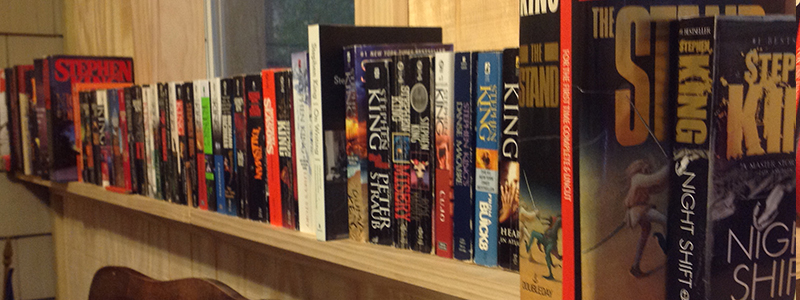by Jay Wilburn
The plan is to reread all of Stephen King’s novels and collections and assorted other publications in their order of publication. Richard Chizmar of Cemetery Dance set out the challenge for himself and invited others to join in. It is an idea which indulges my obsession with King’s writing. I’m doing it because I am a writer and I want to improve my long fiction and storytelling. I think there are secrets to be discovered or rediscovered in it too. As Chizmar posts his after read posts and Bev Vincent posts his accompanying history, I will add links to those in my corresponding posts.
Here is Bev Vincent’s historic essay.
Here are Richard Chizmar’s thoughts.
You can also go back to the beginning and read Before Carrie and follow all the blog posts through each book.
Here is the link the Master List of all my #StephenKingRevisited posts.
Much of what I write in these posts will really be notes for me. I will do my best to make them into coherent observations for you. I will also style my comments to be as spoiler free as possible for those who haven’t read the book, but in a way which will also work for those who have read the books. Be warned though that I am discussing the content of the book and the writing.
Shall we begin to follow the man in black across the desert?

“The man in black fled across the desert, and the gunslinger followed.” Many fans believe this is his best opening line ever.
The book is dedicated to Ed Ferman, who took a chance on these stories, one by one.
The book has a new introduction and a new foreword in this edition. There is new material too! Is he doing that with all the books?! Do I need to buy all updated versions? Apparently, there are 35 more pages in this version of the story. He revised the language of the story a good bit. Reading this fact makes me a little afraid. As I read the story so distant from my first reading (19 a couple times over, as King will put it), I don’t recall what is new and what I forgot.
Tolkien was huge through the 1960’s and influenced King to think about writing an epic fantasy. I think that influence stands out strongest as the characters move through a long underground dark tunnel and fight the Slow Mutants. He didn’t want to do wizards and elves because there were plenty of those already. He had a story of his own to tell. He just didn’t know what it was yet.
King discusses the huge difference between being 19 years old versus 19 x 2 or 3. “Patrol Boy” comes around to beat down the dreamer. People keep asking him how it all comes out and King has to admit that he doesn’t know (or he didn’t know). As he’s been attacked by “Patrol Boy” more than once as he reached 19 several times over, he stopped believing he had forever to live and decided to strive to finish the series. This probably explains how we got books five, six, and seven out back to back not long after On Writing and his van accident.
Fans of The Stand and The Dark Tower are his most intense and passionate. More have read The Stand though. He ponders the meaning and potential of this some in these musings on The Dark Tower series.
“The world had moved on since then. The world had emptied.” Good lines.
Lots of people calling each other maggots again.
We learn about our main character all alone building a campfire, but so much more is going on. Every single sentence and phrase is captivating. I love the whole book, but I’m not sure the ending is nearly as strong as the beginning. Every dirty detail paints a world and communicates a universe. I didn’t recall that the gunslinger’s name wasn’t given at the beginning of the story.
As the gunslinger recounts the night of a formal dance, the narrative description between dialogue goes very high-minded on the vocabulary.
A “taheen” is described. This one is the body of a man with the head of a raven.
They believe in “the man Jesus.” The Lord’s Prayer comes up. They also play Methodist hymns ragtime. Roland doesn’t know about Moses though. Paper is rare and precious in this world and Roland may not have read the Bible stories for himself in whatever form they reached his world.
They play “Hey Jude” as a frequent folk/ bar song. Merlin and King Arthur are part of this world. An Amoco pump becomes a totem to a thunder god. The boy mentions “Simon Says,” but the gunslinger knows it as “Mother Says” in his world.
“Only still living out of habit …” Good line.
“Do you believe in an afterlife?” … “I think this is it.” Great exchange.
The Man in Black speaks of “the World Next Door.”
“Lights that will drive a man mad …” The dead lights of cosmic horror and of the book It. Roland, the gunslinger, sees them in a vision I think and then the secret of “the size” of the universe within universes. Their entire universe possibly contained in atoms within a blade of purple grass. Then, maybe the world moved on because the grass has been cut.
Roland recognizes the piano player, Sheb, from his past. I wonder if that was in the first version of the book or added into this version for continuity.
“La Merk” or “La Mark” is dropped in for some foreshadowing.
“He only saw her once more alive.” This is a favorite foreshadowing move by King.
Jake is met at The Way Station and I forgot that Jake had to be Drawn again later in the series.
“Was there ever a trap to match the trap of love?” King uses a doomed relationship to add weight throughout the journey.
“Beware the man who fakes a limp.” Great line.
Farson and poisoned meat are mentioned in a flashback. As I understand, Farson used to be a town name, but then evolved into a character later. This is probably a revision to this edition to fix that switch. The resulting execution in this flashback plays a big role in Roland’s development.
I get the impression here that Roland either killed his mother or acted in a way which resulted in her death.
“The boy found the oracle and it almost killed him.” This is as good as any first line to a novel.
“an impersonality” What an incredible word.
The gunslinger uses mesciline as a mind-expanding drug. The drawing of the three was prophesied by the succubus. The gunslinger submits to the sexual desires of others quite often. Women and demons just keep throwing themselves at him.
He comes face to face with the Man in Black just twenty feet away. Then, they are led into the extended darkness. The gunslinger takes three shots and misses. He unloads another time later and misses every time despite being a crack shot everywhere else in the story. His incapability to hit or grasp the Man in Black is left to the reader to interpret.
They eventually find a handcar with a mechanical voice of encouragement and advertisement – a hint at a much different world under the ruin of time.
“They went on for three “days” without incident.” This is an entire chapter by itself after an underground action scene with mutants.
“Perpetual Motion was a fool’s dream …” This is a line I remember from my first reading of the book. It stuck with me when so much more of the book fell away over the years. Not sure why. The thought of a great “Central Station” being left in ruin with machines winding down over endless time caught me.
The “Werewolf” trope is mentioned in this book too. This has come up a lot in King’s work following Danse Macabre. The “monster within” and the man transformed into the creature underneath even if it isn’t a physical transformation. This reinforces to me that he wrote Danse Macabre when he did partly to crystallize his own thinking on his horror going forward.
Roland’s vision of the universe and the terror of a light which threatens to steal sanity comes at the end with an odd encounter with the Man in Black which results in him catching the man who may have tormented him his entire life, but he still does not succeed in grasping him as much as he just succeeds in outliving him. He glimpses the truth of a multiverse of infinities on top of infinities. A sort of “non living brain” which holds it all together without caring as it falls apart. It’s an odd ending with a ten year conversation through an endless night which ages our hero. It sets the stage for the next book without any climactic battle with the Man in Black we might have been expecting. The Man in Black is just a minor messenger and a minor player for bigger and darker kings who seem to rule time and space, but can’t snap out the gunslinger the way they so easily did others.
We have a great, mysterious fantasy on our hands with The Dark Tower.
Thanks for reading my ramblings on a greater writer’s work.
My next post will be Before Different Seasons.
— Jay Wilburn





